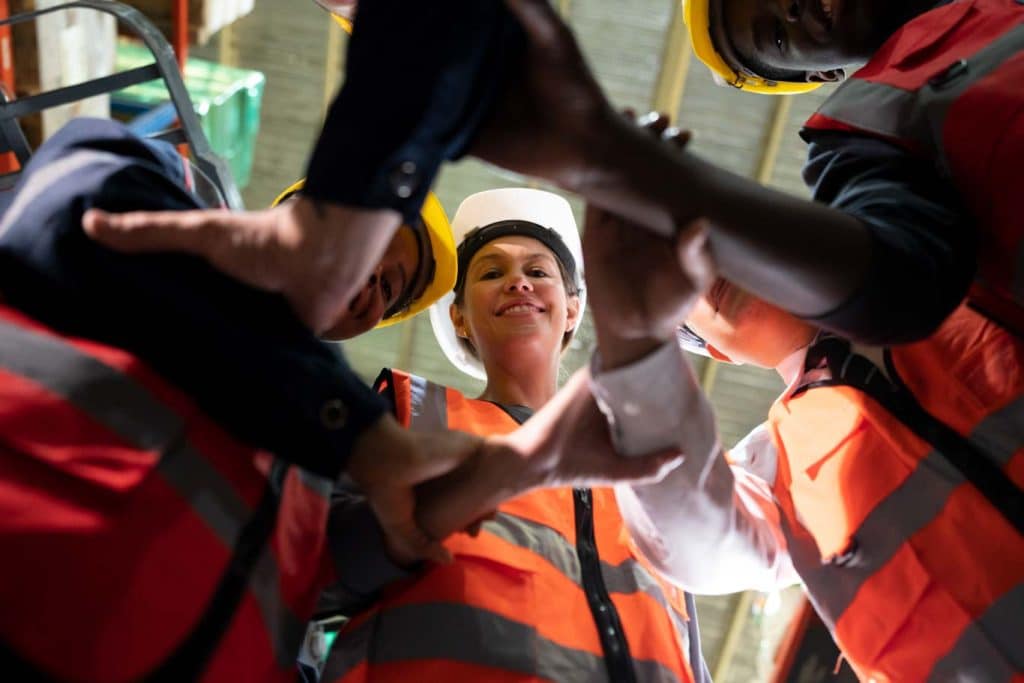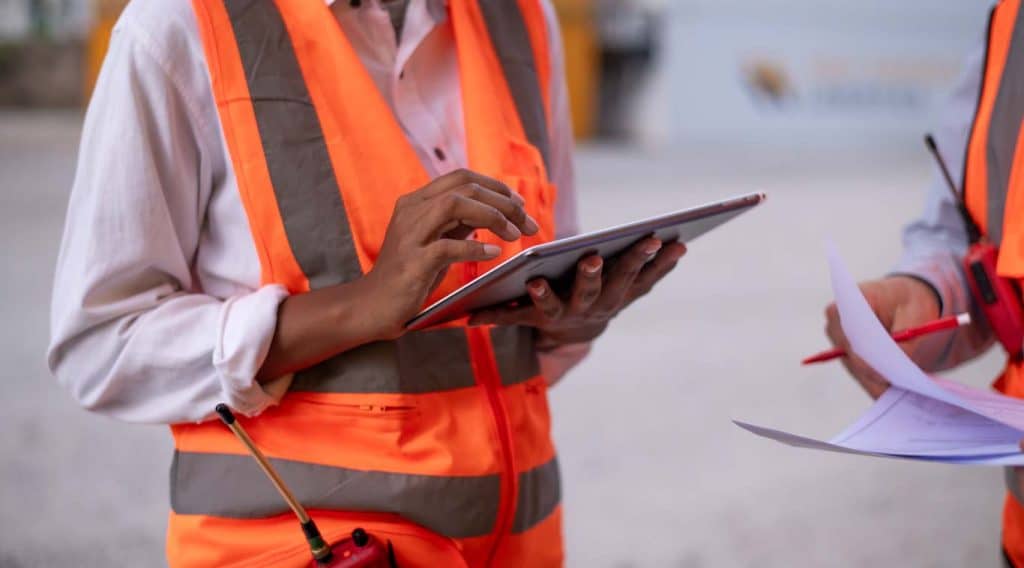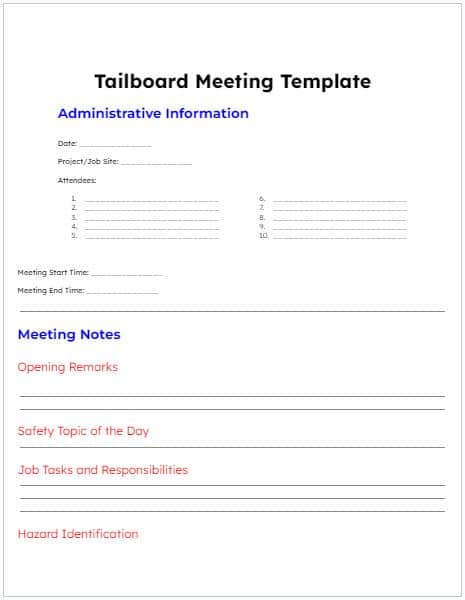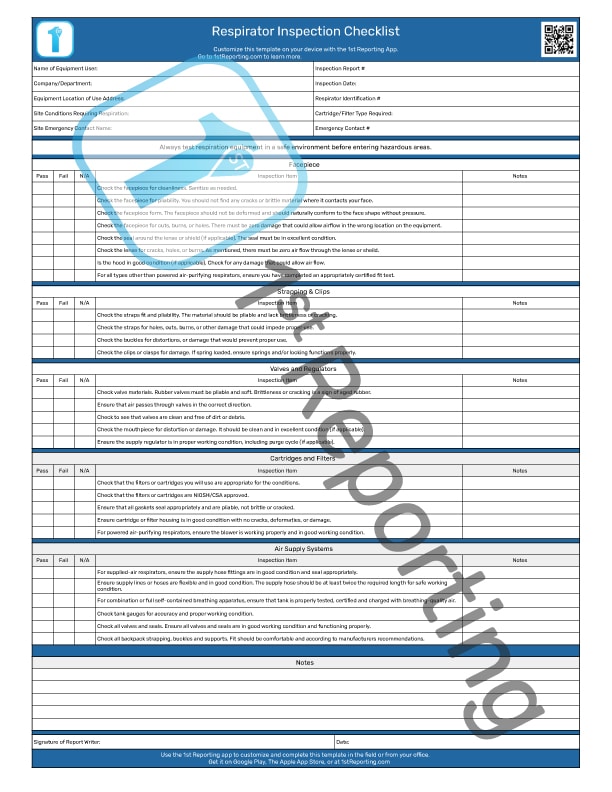A tailboard meeting form helps you manage tailboard meetings, also known as toolbox talks, safety talks, or pre-work safety meetings. These meetings are necessary steps in ensuring that the day’s tasks are managed effectively and that safety is at the forefront of everyone’s mind.
The problem I found when I ran tailboard meetings was that I did not work out all the nuts and bolts of meeting management in the first few attempts. I could have used a guide. That is, it took me a while to really hit my stride when it came to running pre-work safety meetings.
After many years of running safety meetings, I developed a system and a template that I started to use, which helped keep me on point while I was managing multiple projects. This template for the tailboard meeting form, which I created, worked seamlessly with several companies I’ve worked with and continues to work for me today.
In this guide, I’ll provide an in-depth look at the tailboard meeting form template, which I used to run tailboard meetings for many years. Furthermore, I’ll share some of the tips and advice that helped me run highly effective and efficient meetings.
For clarity, I have broken down this guide into three main sections:
- Understanding tailboard meetings,
- 2. Transitioning to digital forms for tailboard safety meetings and
- 3. The features of an effective digital tailboard meeting form and how you can use it to create efficient meeting workflows.
So, lower your tailboard, grab a coffee, and let’s get started.
Section 1: Understanding Tailboard Meetings

Sure, you already know what a tailboard meeting (aka toolbox talk or safety talk) is, but do you have the perspective needed to expedite meeting agendas while simultaneously motivating your team successfully? Let’s make sure we’re on the same page first.
What is a Tailboard Meeting?
Tailboard meetings are crucial to keep the safety mindset going while also getting your team started on a planned day of tasks. However, it’s vital to ensure that it’s not just a one-way lecture but instead more like a conversation where dangers receive full consideration. (1)
Critical Components of a Tailboard Meeting
- Safety protocols
- Task assignments
- Hazard identification
- Crew communication
There are actually 14 components needed, but it’s a bit much to get into here. If you’d like to dive into the details, take a look at our other guides on tailboard meetings and forms in our 1st Reporting blog.
Tailboard meetings are always different, yet you may find that, as I did, some topics are best presented a few times a year. Take slips, trips, and falls, for example, being the third highest cause of DART cases, totaling over 674,000 cases over 2021-2022. (2)
Specific topics, like safety when working on elevated platforms, are often best covered once each quarter. That’s where a tailboard template comes in handy. You can use it as a model for repeat safety topics, modifying only the relevant sections to accommodate any change in site conditions or other hazards (such as when working at a new job site). Let’s see how to transition to digital templates next so you can make your job running tailboard meetings that much easier.
Section 2: Transitioning to Digital Forms For Safety Meetings

Why Move to Digital Forms?
Efficiency and accuracy are paramount in field operations. Whether you’re managing a construction crew or a team of mobile service workers, optimizing your processes can lead to significant gains in productivity. Transitioning from paper forms to digital forms for tailboard meetings is a powerful way to achieve this. Here are my top ten reasons why you need to make the move:
- Improved Efficiency and Speed
You’ll enable your team to submit forms instantly using mobile devices, which means no more delays from manual data entry. Digital forms streamline the entire process, allowing your team to focus on other critical tasks rather than paperwork.
- Enhanced Accuracy and Consistency
Digital forms reduce human error. With predefined fields and formats, you ensure consistent data collection across all reports. I say no more struggling with illegible handwriting or missing information.
- Real-Time Data Access and Management
With digital forms, you gain immediate access to data from the field. This real-time availability allows you to make informed decisions quickly. Plus, centralized storage in the cloud means you can retrieve any report without sifting through physical files.
- Improved Compliance and Reporting
Automated record-keeping ensures that all data entries are accurately logged and stored. It is crucial for compliance audits. Customizable reports make it easier to meet regulatory requirements and maintain accurate records.
- Enhanced Safety and Emergency Response
Set up real-time notifications to alert relevant personnel immediately when incident report submission occurs. GPS integration helps you track the exact location of reports, improving situational awareness and emergency response.
- Cost Savings
Switching to digital forms reduces the cost of paper, printing, and storage. Automating data processing also reduces administrative labor costs, allowing you to allocate resources more effectively.
- Better Data Security and Accessibility
Digital forms stored in the cloud benefit from advanced security, ensuring that your data is protected. You can also control who has access to sensitive information, enhancing overall security. Ensure that the provider is ISO-certified, as the 1st Reporting app is; that way, you know they are serious about your data security.
- Environmental Benefits
Going digital reduces paper waste and the environmental impact associated with paper production and disposal. It not only helps the planet but also promotes a sustainable image for your organization.
- Scalability and Customization
Digital forms are easily scalable, accommodating your business’s growth without the need for additional physical storage. You can customize forms to meet specific needs, ensuring they’re always fit for purpose.
- Integration with Other Systems
Digital forms can integrate with your existing business systems, facilitating seamless data flow. This integration enhances overall operational efficiency by ensuring that all your data is connected and easily accessible.
Switching to digital forms for tailboard meetings offers numerous advantages that enhance efficiency, accuracy, and safety. It can transform your field operations and provide substantial benefits for your organization.
Benefits for Enterprise-Tier Management
There are three primary benefits to enterprise-caliber managers:
- Enhanced visibility and control over field operations.
- Improved compliance and reporting.
- Faster emergency response times.
Section 3: Features of an Effective Digital Tailboard Meeting Form

Having a digital form is a little more complicated than it may appear on the surface, so it’s best to understand two things right off the bat:
- Your organization’s operational needs. Is the form customizable? If not, that will be a problem.
- Understand the features you want. Understanding how you need the form to work for you and the features you want to accompany it are crucial in determining which solution is the most appropriate for long-term and possibly scalable success.
Essential Features to Include
Customization Options and Pure Functionality
Tailoring forms to specific business needs is the most important feature, aside from workflow use, of course. A customizable form can be useless in the field due to poor functionality. On the other hand, forms that work great in the field but aren’t customizable can also be helpful, so the function is as essential, in my opinion, as customizability.
GPS Integration
Tracking the time and location of tailboard meetings via a digital solution with GPS-integrated software is essential. It provides insight into management and accountability for those hosting or attending the tailboard meeting.
Real-Time Notifications
One of the features I like about 1st Reporting – an app for managing and handling any customizable form for field crews, is the customizable trigger and condition notification system.
Picture this: you’ve got meetings all day and can’t make it to the site to check up on your work crews. So, you provide your teams with a standard operating procedure (SOP) that dictates their responsibilities to complete a pre-work site hazard audit and a tailboard safety meeting to get the teams started safely, as well as typical pre-use PPE and equipment inspections.
Using 1st Reporting, you could do this and add custom notifications that trigger specified actions and conditional triggers, like a notification when a team member starts a tailboard meeting and a notification when the team completes their tailboard meeting.
Now, with only a couple of notifications, you have insight into when, where, and how long a tailboard meeting occurred. These sorts of customizable notifications, when combined with the robust form builder, become a potent weapon in your management arsenal.
Dynamic Linking
While we’re on the subject of preferential features for a tailboard meeting form in digital format and while I share my experience using 1st Reporting with you, let’s talk about customization and dynamic linking.
Within the 1st Reporting app’s custom form builder, there’s a field called ‘Relationship’ that you can add to your form. This customizable element allows you to connect automation, like dynamically starting a different form and connecting it to create a workflow. Here’s an example of what I mean:
Pretend you’re running a typical tailboard meeting, and one of your team members points out a particular hazard that has come up unexpectedly and needs attention. Using the 1st Reporting app and a customizable tailboard meeting form template, you could have a field where, if unexpected hazards like this arise, you could click a field to start a hazard recognition report and start the work mitigating the hazard.
The dynamic form relationship field is customizable, so in practice, you could link anything from an equipment repair work order to a pre-use equipment inspection report or an accident report linked to an injury response report; you get the idea.
Because it’s customizable, the potential for creating dynamic automated workflows to help speed up your team, emergency responses, or any other tasks is only limited by how you can imagine a workflow proceeding.
Maximize Efficiency and Safety with Digital Tailboard Forms

Transitioning to digital tailboard meeting forms isn’t just a trend—it’s a strategic move towards enhanced efficiency, accuracy, and safety. By adopting these modern solutions, you can streamline operations, ensure regulatory compliance, and foster a proactive safety culture within your organization.
Don’t wait to experience the transformative benefits of digital forms. Contact the 1st Reporting team today to book a demo of how their customizable mobile solutions can elevate your field operations to the next level. Or, if you’re in a hurry, try the application now with a free trial (click the button below).
Article Sources
- “LinkedIn.” 2024. Linkedin.com. 2024. https://www.linkedin.com/pulse/tailboard-meeting-must-do-you-staff-understand-why-terry-penney/.
- “Top Work-Related Injury Causes – Injury Facts.” 2024. Injury Facts. February 7, 2024. https://injuryfacts.nsc.org/work/work-overview/top-work-related-injury-causes/.
- “Template Archive – 1st Reporting.” 2024. 1st Reporting. 2024. https://1streporting.com/templates/.




